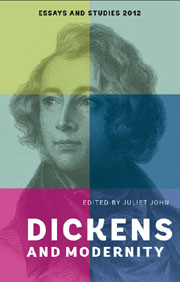Book contents
- Frontmatter
- Contents
- LIST OF ILLUSTRATIONS
- ACKNOWLEDGEMENTS
- NOTES ON THE CONTRIBUTORS
- INTRODUCTION
- 1 THE DICKENS TAPE: AFFECT AND SOUND REPRODUCTION IN THE CHIMES
- 2 DICKENS, SEXUALITY AND THE BODY; OR, CLOCK LOVING: MASTER HUMPHREY'S QUEER OBJECTS OF DESIRE
- 3 TEXTS, PARATEXTS AND ‘E-TEXTS’: THE POETICS OF COMMUNICATION IN DICKENS'S JOURNALISM
- 4 CORPUS STYLISTICS – DICKENS, TEXT-DRIVENNESS AND THE FICTIONAL WORLD
- 5 THINGS, WORDS AND THE MEANINGS OF ART
- 6 DICKENS AND THE CIRCUS OF MODERNITY
- 7 THE OLIVER! PHENOMENON; OR, ‘PLEASE, SIR, WE WANT MORE AND MORE!’
- 8 ‘WOW! SHE'S A LESBIAN. GOT TO BE!’: RE-READING/RE-VIEWING DICKENS AND NEO-VICTORIANISM ON THE BBC
- 9 OUT OF PLACE: DAVID COPPERFIELD'S IRRESOLVABLE GEOGRAPHIES
- 10 AFTERWORD: THE 2012 BICENTENARY
- Index
8 - ‘WOW! SHE'S A LESBIAN. GOT TO BE!’: RE-READING/RE-VIEWING DICKENS AND NEO-VICTORIANISM ON THE BBC
Published online by Cambridge University Press: 05 February 2013
- Frontmatter
- Contents
- LIST OF ILLUSTRATIONS
- ACKNOWLEDGEMENTS
- NOTES ON THE CONTRIBUTORS
- INTRODUCTION
- 1 THE DICKENS TAPE: AFFECT AND SOUND REPRODUCTION IN THE CHIMES
- 2 DICKENS, SEXUALITY AND THE BODY; OR, CLOCK LOVING: MASTER HUMPHREY'S QUEER OBJECTS OF DESIRE
- 3 TEXTS, PARATEXTS AND ‘E-TEXTS’: THE POETICS OF COMMUNICATION IN DICKENS'S JOURNALISM
- 4 CORPUS STYLISTICS – DICKENS, TEXT-DRIVENNESS AND THE FICTIONAL WORLD
- 5 THINGS, WORDS AND THE MEANINGS OF ART
- 6 DICKENS AND THE CIRCUS OF MODERNITY
- 7 THE OLIVER! PHENOMENON; OR, ‘PLEASE, SIR, WE WANT MORE AND MORE!’
- 8 ‘WOW! SHE'S A LESBIAN. GOT TO BE!’: RE-READING/RE-VIEWING DICKENS AND NEO-VICTORIANISM ON THE BBC
- 9 OUT OF PLACE: DAVID COPPERFIELD'S IRRESOLVABLE GEOGRAPHIES
- 10 AFTERWORD: THE 2012 BICENTENARY
- Index
Summary
Then there are the lesbians. What, you don't remember them in Dickens? You weren't paying enough attention. (Moreton, 2008)
‘I'm a big Dickens fan’, confessed Sarah Waters in an interview; ‘His preoccupations […] with class, with desire, with guilt, and with the gothic traumas of maturation and love – still seem enormously resonant to me’ (Waters, quoted by Pete Bailey). Speaking as a neo-Victorian novelist, the ‘resonance’ that Waters has in mind invokes a reverberating movement, a conceptual shifting backwards and forwards between Victorian and post-modern periods and values that engenders a proximity of feeling to the frustrated and unresolved intimacies of Dickens's fiction. It has been in her re-readings of Dickens and rewritings of the Victorian past that Waters has taken the focus of a queer, revisionist lens through which to reconsider the sexually subversive tensions and suppressed homosexual identities that discreetly exist within the nineteenth-century literary text, popularly recasting Waters as the ‘lesbian Charles Dickens’, in the phrase of Kirkus Reviews ([Anon.]). This process of (re)presenting thwarted lesbian desire has proved to be hugely popular as well as radical, having succeeded, according to Kate Mitchell, in ‘silently’ inserting ‘nineteenthcentury female homosexuality into our cultural memory of Victorian fiction’ (118). If this is so, then Waters's fiction has opened up an important, transitional interpretative space, through which understandings of homosexuality in the Victorian era can be interrogated and explored, new interpretations may be conceptualised and competing cross-currents of similarity and difference brought into sharp relief.
- Type
- Chapter
- Information
- Dickens and Modernity , pp. 171 - 192Publisher: Boydell & BrewerPrint publication year: 2012



